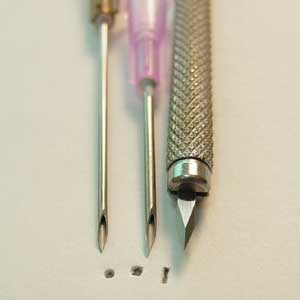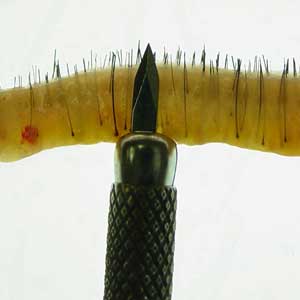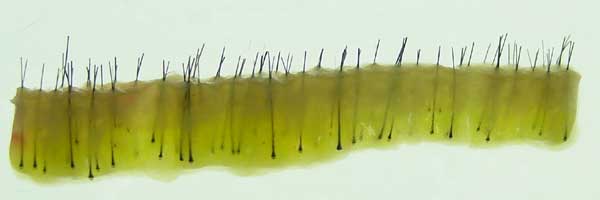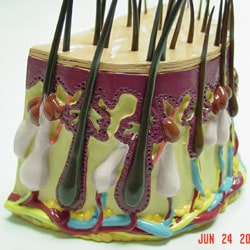Single Follicular Units
A. Hair transplantation has advanced due to the change & decrease in graft size. Since 1990’s, the H.T Surgeons introduced the concept of the follicular unit. Now when we discuss about the size of a graft, follicular units are the most popular and prominent term. Almost everyone believes that follicular units are the best size grafts for hair transplantation, but are follicular units really the most suitable size graft for the patient? Some people use follicular units as a means for comparison between different clinics. Now, 8 years after the concept of follicular units was introduced, a lot of clinics even have to claim that they only perform 100% follicular units to help persuade patients. This paper will take a closer look to see if it really is in the best interest of a patient to do a 100% follicular unit procedure. First, let’s take a look at some of the claims why some doctors believe that follicular units are the best choice.
| ||||||||||||||||||||
| ||||||||||||||||||||
In our surgical center, we use 3 sizes of grafts: single hair grafts, follicular units, and modified follicular units. We use single hair grafts and follicular units for the hairline only, while modified follicular units are the basic size for the rest of the grafts. Why use modified follicular units instead of single follicular units? What are the advantages of it? Response to Claim #1 | ||||||||||||||||||||
|

For the 19G needle, 18G needle and SP Mini-Blade, the length of the wound size of 1000 grafts would be 1080 mm, 1260 mm and 985 mm respectively. The SP Mini-Blade has the shortest size of wounds and therefore should have a quicker healing period.

Additionally, when we mention wound size, we should mention both the length and the depth. For hair transplant, the depth is especially important. Please see the picture. The microcirculation is just beneath the hair follicle; too deep an incision would unavoidably damage it. To allow the growth of new implanted grafts, we should reduce the damage of the surrounding tissue to a minimum.

The 19G and 18G needles cannot control the depth of incision, so there is a high chance that the incision will be too deep or too shallow. If the incision is deeper than the hair bulb, it will most likely puncture the microcirculation. On the other hand, if the incision is too shallow, then graft insertion will be very difficult, if at all possible. With the mini-blade, however, we are able to set the length of the blade to exactly the right size that we need (as seen in picture), so there is more control of the depth of incision.

Response to Claim #2
We use a mini-blade (not laser, not punch) to achieve our high level of results. There is no extraneous tissue removed. However, for physicians using the 18G and 19G needles, tissue may occasionally be removed because of the small holes that are in the middle of the needle. The needle works as a puncture, and therefore, there might be unnecessary removal of tissue from the scalp.
Response to Claim #3
Please view the photo of the donor strip. We can see non-hair bearing skin makes up at least 50% of the strip. As learned from other studies, more than 10% of the hair is invisible because they are at the resting phase. When you remove any of the non-hair bearing skin, you automatically lose this 10% of hair. There is one report, which came from Dr. Kolasinski in Poland Nov 2001. In his study, he reported that he had transplanted 15 non-hair bearing grafts— no visible hair follicles— in a patient. 7 months post-operative, there was a re-growth of 35 hairs from these grafts. Amazingly, each non-hair bearing graft yielded about 1 to 3 hairs per graft. From the results of that study, we can conclude that the best hair transplant procedures are the procedures that transplant 100% of the donor tissue to the recipient site without removing any of the tissue. Non-hair bearing tissue today does not mean that there is no hair in the tissue at all, but just means that the hair is not clearly visible.
Response to Claim #4
Our basic graft size- the modified follicular unit- is double the size of a single follicular unit. Please see our results in the zoomed-in photos and videotapes. Do they look pluggy or unnatural? Undeniably, the size of the graft is a big factor concerning a pluggy and unnatural look. But a more important factor is the uneven distribution of grafts and very large empty spaces between the grafts. Even for a 100% single follicular unit transplant, if the grafts are not close enough, then the results will still look pluggy. For the past ten years, we have repaired hundreds of pluggy-looking patients. For patients with the older 4 mm grafts, instead of removing these pluggy grafts, we only fill in the empty spaces between the grafts as much as possible. Please see the pictures for an example of our results. (The only exception is when the pluggy hairline is too low then we may have to remove some pluggy grafts). If you were able to fill in all of the empty space between the grafts and achieve equal density everywhere, then even if you don’t remove any of the big plugs, the pluggy-look will disappear. This is the principle that we have been using for correction of the unnatural pluggy appearance.
Contradictions for Follicular Units
For patients with curly hair or white hair, we especially do not recommend the practice of only using single follicular units. The reason for this is that curly hair is not only curly on the outside, but even the hair stem within the tissue is curly. It is extremely difficult to avoid damage to these grafts. The more one cuts the strip, the more damage one will make. White color hair poses a different problem because it is extremely hard to see even under the microscope. The reason for this is that white hair is the same color as the tissue. Just like writing with black ink on black paper, no matter how much you enlarge a white hair donor strip, it will still be very difficult to see. Even under the microscope, white hair is not clearly visible. Therefore, the more grafts that you cut from a curly donor strip or white donor strip, the more risk of damage you will incur.
Comparison Study – Please view our comparison study to see the differences between a follicular unit procedure and a modified follicular procedure.
Conclusion
The purpose of using single follicular units is to obtain a natural look. For the hairline, we still use single follicular units and even single hair units. We agree that those are the best options for the hairline. But for density purposes, we prefer to use the modified follicular units for the coverage of the rest of the area. Our conclusion is that for the hairline, we should use single follicular units even only single hair grafts to achieve a natural look. But for the rest of the area, we should use modified follicular units to achieve more density. The final goal for a hair transplant is the combined result of an undetectable hairline and added density for the other areas



